
Drexel University is a private research university with its main campus in Philadelphia, Pennsylvania. Drexel's undergraduate school was founded in 1891 by Anthony J. Drexel, a financier and philanthropist. Founded as Drexel Institute of Art, Science and Industry, it was renamed Drexel Institute of Technology in 1936, before assuming its current name in 1970. As of 2020, more than 24,000 students were enrolled in over 70 undergraduate programs and more than 100 master's, doctoral, and professional programs at the university.
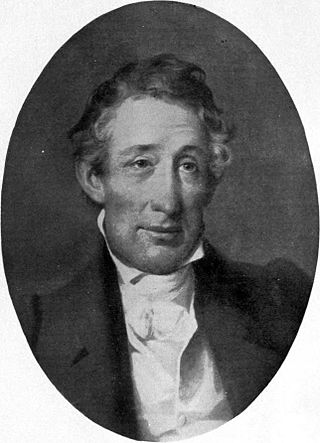
George Ord, Jr. was an American zoologist who specialized in North American ornithology and mammalogy. Based in part on specimens collected by Lewis and Clark in the North American interior, Ord's article "Zoology of North America" (1815), which was published in the second American edition of William Guthrie's Geographical, Historical, and Commercial Grammar, has been recognized as the "first systematic zoology of America by an American".

Kootenay National Park is a national park of Canada in southeastern British Columbia. The park consists of 1,406 km2 (543 sq mi) of the Canadian Rockies, including parts of the Kootenay and Park mountain ranges, the Kootenay River and the entirety of the Vermilion River. While the Vermilion River is completely contained within the park, the Kootenay River has its headwaters just outside the park boundary, flowing through the park into the Rocky Mountain Trench and eventually joining the Columbia River. The park ranges in elevation from 918 m (3,012 ft) at the southwestern park entrance to 3,424 m (11,234 ft) at Deltaform Mountain.

Thomas Say was an American entomologist, conchologist, and herpetologist. His studies of insects and shells, numerous contributions to scientific journals, and scientific expeditions to Florida, Georgia, the Rocky Mountains, Mexico, and elsewhere made him an internationally known naturalist. Say has been called the father of American descriptive entomology and American conchology. He served as librarian for the Academy of Natural Sciences of Philadelphia, curator at the American Philosophical Society, and professor of natural history at the University of Pennsylvania.

The Academy of Natural Sciences of Drexel University, formerly the Academy of Natural Sciences of Philadelphia, is the oldest natural science research institution and museum in the Americas. It was founded in 1812, by many of the leading naturalists of the young American republic with an expressed mission of "the encouragement and cultivation of the sciences". It has sponsored expeditions, conducted original environmental and systematics research, and amassed natural history collections containing more than 17 million specimens. The Academy also organizes public exhibits and educational programs for both schools and the general public.
Driftwood Canyon Provincial Park is a provincial park in British Columbia, Canada. Driftwood Canyon Provincial Park covers 23 ha of the Bulkley River Valley, on the east side of Driftwood Creek, a tributary of the Bulkley River, 10 km northeast of the town of Smithers. The park is accessible from Driftwood Road from Provincial Highway 16. It was created in 1967 by the donation of the land by the late Gordon Harvey (1913–1976) to protect fossil beds on the east side of Driftwood Creek. The beds were discovered around the beginning of the 20th century. The park lands are part of the asserted traditional territory of the Wet'suwet'en First Nation.
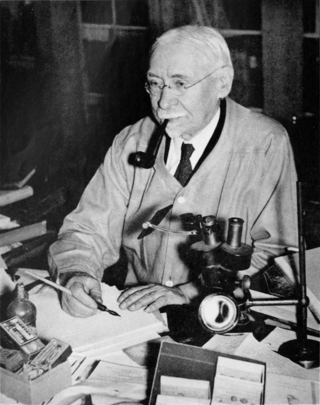
Henry Augustus Pilsbry was an American biologist, malacologist and carcinologist, among other areas of study. He was a dominant presence in many fields of invertebrate taxonomy for the better part of a century. For much of his career, his authority with respect to the classification of certain substantial groups of organisms was unchallenged: barnacles, chitons, North American terrestrial mollusks, and others.
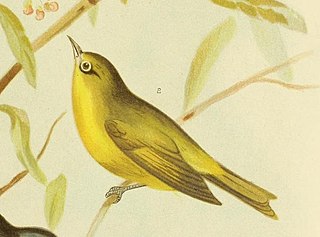
The canary white-eye or yellow white-eye is a species of white-eye endemic to northern Australia in subtropical or tropical mangrove forests. Its common name reflects the circle of white feathers around its eye.

The Franklin Mountain woodland snail is a species of land snail in the family Polygyridae. It is native to New Mexico and Texas in the United States.

Ashmunella is a genus of small, air-breathing, land snails in the family Polygyridae.
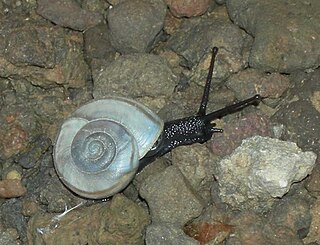
Sonorella is a genus of land snails in the subfamily Helminthoglyptinae. They are known commonly as talussnails or talus snails because most live in talus and similar habitat. They are distributed across the southwestern United States and adjacent Mexico. There are about 80 species.
Shelter Cave is an archaeological and paleontological site located in Doña Ana County, New Mexico.
Daniel Otte is a South African-American ecologist, entomologist, world expert on crickets and grasshoppers and prominent scientific illustrator. He has made significant contributions to evolutionary biology. He is curator and chairman of the Department of Entomology at the Academy of Natural Sciences in Philadelphia.
Gary Rosenberg is an American malacologist.
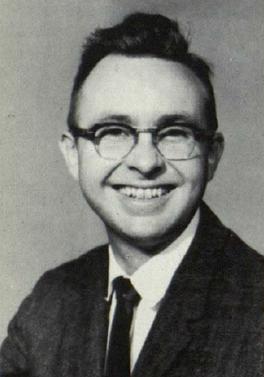
Artie Lou Metcalf was an American malacologist.

Arthur H. Harris is an American mammalogist and paleontologist.
Ashmunella todseni is a species of air-breathing land snail, a terrestrial pulmonate gastropod mollusk in the family Polygyridae.

John Krider was an American gunsmith and ornithologist who operated a sporting goods store on the northeast corner of Second St. and Walnut St. in Philadelphia, Pennsylvania, for much of the 19th century. On the second floor of Krider's shop was a taxidermy shop, where hundreds of bird specimens were prepared over multiple decades.

Howard Radclyffe Roberts Jr. was an American entomologist known for his work on grasshoppers. His 1941 University of Pennsylvania Ph.D. dissertation was an early work highlighting the role phallic structures could play in grasshopper taxonomy. While serving in World War II, he and Edward Shearman Ross cowrote The Mosquito Atlas, used by the armed forces to identify malaria-transmitting mosquitos. Roberts worked for the Academy of Natural Sciences of Philadelphia (ANSP), serving as its managing director from 1947 to 1972. He described dozens of grasshopper species from North and South America, and also is the eponym of several taxa named in his honor.
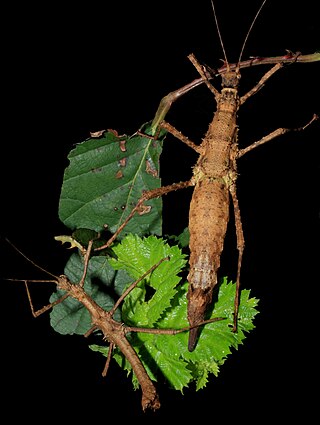
Brasidas lacerta is a species of stick insect in the family Heteropterygidae which is endemic to Mindanao. Due to its extreme variability, and the nymphs being spinier than to the adults, the species has been described under other names, resulting in a total of seven synonyms.














